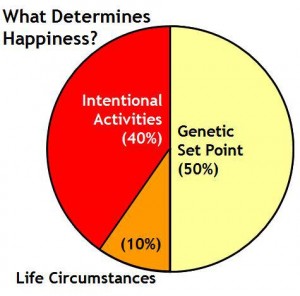Happiness Is Not a Passive Endeavor, Part I
Posted on November 4, 2014 by Lauri Ringer
Benjamin Franklin knew that happiness was not a passive endeavor, as evidenced by his statement, “The U.S. Constitution doesn’t guarantee happiness, only the pursuit of it. You have to catch up with it yourself.” Today, almost two-and-a-half centuries later, Franklin’s words still prompt the question, What are the factors that lead to a successful pursuit of happiness?
To find out, neuroscientists and psychologists have studied happiness in cultures all over the world. They’ve incorporated economic, health, and social impacts into their data and have identified three components, in particular, that they believe are the underlying basis for happiness — genetics, circumstances, and intentional activities.
 The first component, genetics, accounts for 50 percent of the underlying causes of happiness. This 50 percent is the genetic baseline, or set point.
The first component, genetics, accounts for 50 percent of the underlying causes of happiness. This 50 percent is the genetic baseline, or set point.
Some people’s baselines are wired for optimism, while others are wired for discontent. This is why some people appear to be perpetually disgruntled, even when things seem to be going well. Conversely, it’s why others never seem to sweat the small stuff and adapt easily to changing circumstances.
The second underlying component, circumstances (e.g., social status, health, age, or income), account for only 10 percent of an individual’s happiness. The circumstances can be pleasant or unpleasant, but they rarely have a permanent impact on a person’s satisfaction with life.
The reason for this is that the genetic happiness baseline dominates a person’s perspective. With a circumstantial blow — say, to health or finances — there can be a transitory period of unhappiness, but the person’s happiness baseline will remain relatively stable. The inverse is true, as well.
When someone’s circumstances improve, perhaps because of a job promotion or weight loss, there will be a transitory stage of euphoria that eventually will adjust to the genetic baseline. Thus, even when our circumstances or demographics change, our happiness baseline, or “set point,” remains unmoved.
The other 40 percent of happiness is called intentional behaviors or intentional activities. While we cannot control our genes or circumstances (e.g. natural disasters, accidents, terminal or chronic illness), we can control our intentional behaviors.
Scientific research reveals that intentional activities enable a successful pursuit of happiness. Just as gasoline powers an automobile and food powers the body, intentional behaviors power our happiness engines and supersede our genes and circumstances. In fact, our intentional behaviors literally change our brains and result in greater satisfaction with life, better health, and higher achievement of our goals.
From decades of study, researchers have found that happiness falls into two broad categories — extrinsic values and intrinsic values. Extrinsic values involve things outside the self (e.g., money, status, image), while intrinsic values center on inherently psychological needs inside the self (e.g., personal growth, relationships, and community.)
A number of studies have revealed that people with an abundance of extrinsic baggage have reported less satisfaction, less vitality, and more depression, while people rich in intrinsic values have reported the opposite effect on their state of mind. The latter group experiences a high satisfaction-with-life index.
Scientific data also has confirmed that happiness is a state of mind — literally. When something makes a person happy, his brain releases a neurotransmitter called dopamine — the “feel good drug.”
You’ve probably experienced a rush of this naturally occurring drug at some point in your life — perhaps when you’ve fallen in love, won a golf match, or received accolades from your boss or supervisor.
But dopamine is not exclusive to feeling happy. It’s neurotransmitters also play a critical role in motivation, cognition, and memory, as well as in the function of the digestive system, kidneys, pancreas, and motor control.
Dopamine does not regenerate cells, but like the exercise cliché “use it or lose it,” you can strengthen your brain’s ability to produce a flow of dopamine that helps you to maintain mental and physical well-being.
In the next installment of this article, I’m going to discuss how you can exercise your brain to improve your personal satisfaction-with-life index. I’ll also expand on the intrinsic values of personal growth, relationships, and community, and how they impact your health and happiness.
Benjamin Franklin was right. The U.S. Constitution guarantees the pursuit of happiness, but it’s up to you to catch up with it yourself.










